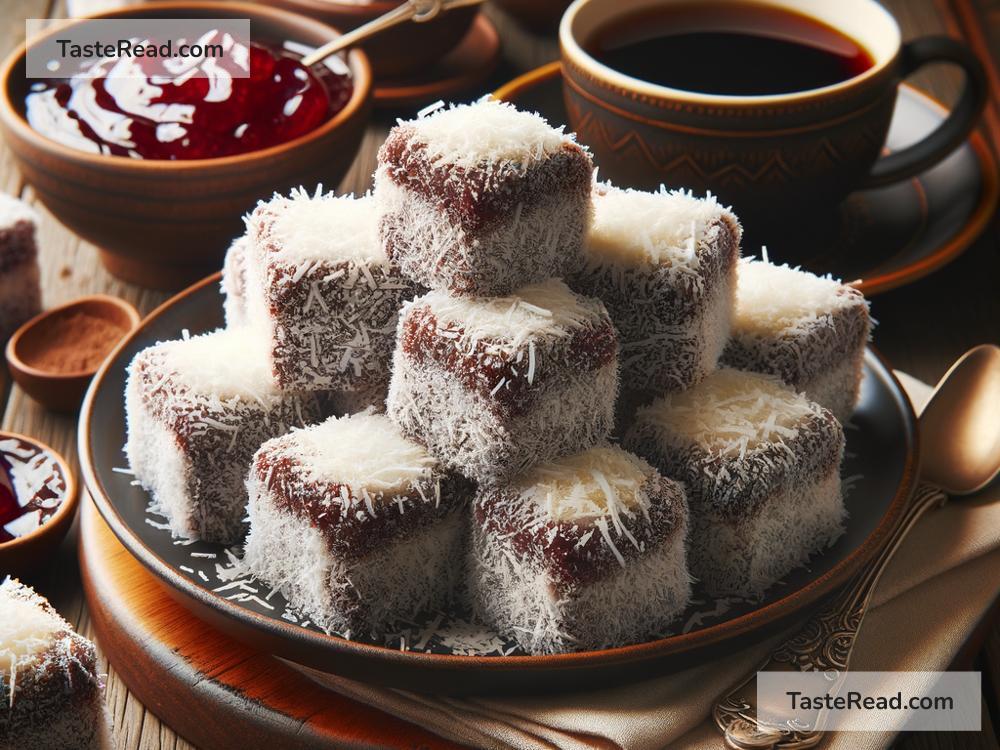The Story of the Australian Lamington: A Sweet Slice of History
If you’ve ever visited Australia, chances are you’ve come across the iconic dessert known as the lamington. It’s a sponge cake coated in chocolate and rolled in shredded coconut, often filled with jam or cream. For many Australians, the lamington is more than just a treat—it’s a symbol of home and tradition. But where did this delicious dessert come from? Let’s take a look at the fascinating story behind the lamington, told in simple English.
What is a Lamington?
Before diving into its history, let’s describe the lamington. It’s usually a square-shaped piece of sponge cake, dipped in a chocolate icing and coated with desiccated coconut. Sometimes, the cake is cut in half and filled with a thin layer of raspberry jam or whipped cream for extra flavor.
Lamingtons are popular in Australia and New Zealand, often served at bake sales, school events, and family gatherings. They’re loved for their simple yet tasty flavor combination and easy-to-make recipe, making them a favorite among both amateur and professional bakers.
How Did the Lamington Get Its Name?
The lamington is named after Lord Lamington, who was Governor of Queensland from 1896 to 1901. Lord Lamington was a British aristocrat who spent much of his life in public service, including his time in Australia’s sunny Queensland. It’s unclear if he personally loved the cake, but his name lives on through this famous dessert.
The most popular story says that the lamington was invented accidentally during Lord Lamington’s time in office. According to this tale, his French-born chef, Armand Galland, had to whip up a dessert quickly for unexpected guests. Legend has it that Galland used day-old sponge cake, dipped it in chocolate to stop it from drying out, and added coconut for texture. The result? A simple yet irresistible dessert that’s been enjoyed by millions ever since.
The Coconut Controversy
Interestingly, early versions of the lamington didn’t include coconut. While the chocolate coating was part of the original recipe, coconut was not commonly used in cooking in Australia at the time. Some believe the addition of coconut was inspired by influences from the Pacific Islands, where coconuts are abundant. Others think it was simply a way to make the dessert look more visually appealing. Whatever the reason, coconut has now become a signature ingredient and an essential part of the lamington’s identity.
Is the Story True?
Although the tale of Lord Lamington’s chef creating this dessert is the most famous explanation, there’s still some mystery surrounding the lamington’s true origins. Some food historians argue that similar recipes existed before Lord Lamington’s time, suggesting the dessert might not have been unique to his household.
A different theory claims that the lamington was actually inspired by a New Zealand dessert, leading to playful debates between Australians and New Zealanders about who invented it first. It’s hard to say for sure, but one thing is certain—Australia has firmly claimed the lamington as its own.
What Makes Lamingtons So Special?
It’s not just the taste that makes lamingtons special—it’s what they represent. For many Australians, lamingtons bring back memories of childhood, family gatherings, and traditional bake sales known as “lamington drives.” These fundraisers, often organized by schools and community groups, involve selling home-made lamingtons to raise money. Seeing boxes of lamingtons lined up at a local event is a familiar and heartwarming sight for many Aussies.
Lamingtons also have their own day of celebration in Australia: National Lamington Day, held annually on July 21st. On this day, Australians celebrate their love for lamingtons by baking, buying, and eating this beloved treat.
Lamingtons Beyond Australia
While lamingtons are an Australian invention, their popularity has spread far and wide. They can now be found at cafés and bakeries around the world, and many international tourists fall in love with them while visiting Australia. Some countries have added their own twist to the recipe, such as using different flavors for the sponge cake or adding unique toppings. However, the classic chocolate-and-coconut lamington remains the favorite and best-known version.
Make Your Own Lamingtons
If you’d like to try making lamingtons at home, the recipe is fairly simple. You’ll need sponge cake (bought or homemade), chocolate icing, and shredded coconut. Start by cutting the sponge cake into small squares, then dip each square into the chocolate icing. Roll the coated cakes in coconut and let them set. If you want to add jam or cream, slice the squares in half and spread the filling before coating them.
Lamington recipes are easy to find online, and many Australians have their own family variations. Whether you stick to the classic version or experiment with new flavors, lamingtons are a fun and rewarding dessert to make.
Conclusion
The story of the Australian lamington is more than just a history of a dessert—it’s a tale of tradition, resourcefulness, and national pride. From its humble beginnings in the kitchen of Lord Lamington to its status as a cultural icon, the lamington continues to bring joy to Australians and dessert lovers worldwide. So next time you bite into a lamington, remember—you’re enjoying a sweet slice of history!


